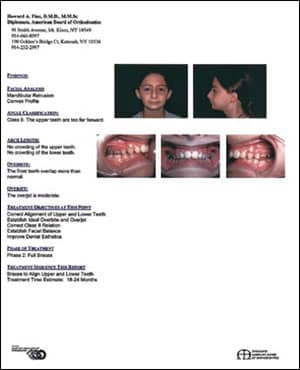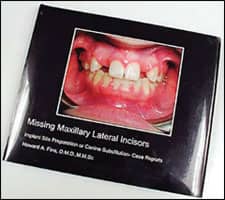by Howard A. Fine, DMD, MMSc
Digital imaging as a marketing tool
 |
In hard economic times, or even in a positive economic environment, marketing your practice is an integral part of practice management. However, if the practice gross decreases, as has happened to a significant percentage of offices during this economic downturn, monies that have traditionally gone to external and internal marketing strategies must now be used to pay normal overhead. Fortunately, there are marketing strategies that can be implemented with minimal or no expense. For example, the digital images we routinely take of our patients on an everyday basis can be used as marketing tools in a number of different ways. In this article, I will discuss using digital images of the patient in 1) stylized reports to the referring dentist and parents; 2) Web site marketing; and 3) professional-looking photo books.
Digital Images
A typical photo montage of a patient contains seven basic views: frontal and profile views of the face; and center, right buccal, left buccal, upper occlusal, and lower occlusal views of the teeth (Figure 1).
 |
| Howard A. Fine, DMD, MMSc |
Often, these basic views are supplemented with smiling photos and 45º views. For marketing purposes, I am going to suggest a specific view that is not typical but is valuable for a number of purposes. This image is a frontal view of the patient smiling, but only from the nose to the chin (Figure 2).
First, this image can help in diagnosis and treatment-planning because it helps define dental and facial midlines, as well as smile dynamics, gingival show, and facial asymmetries. Second, because only part of the patient’s face is in the image, it is difficult to nearly impossible to identify the person. This means that the image can be used in marketing literature without violating patient confidentiality.
Diagnostic Reports
Many practitioners send multipage letters outlining the diagnosis and treatment plan for a patient. Having seen these on multiple occasions accompanying transfer records, I often wonder what the motivation is behind the complexity of these reports. Although they describe the case in detail, I submit that these types of reports are difficult and time-consuming to read and comprehend, and are therefore potentially ignored and filed away. In addition, without incorporating digital images of the patient, it can be difficult for the referrer or parent to accurately recall the initial malocclusion. After discussing this issue with many of my referrers, it is clear that they would rather have a simple, one-page report with photos describing the diagnosis and treatment plan for the patient (Figure 3).
This way, they have at their fingertips a simple, chart-friendly yet comprehensive way of tracking the patient’s progress. In addition, if the wording in the report is not overly technical, the same report can be given to the parent, which increases practice efficiency and allows the digital images to be used in multiple ways.
 |
| Figure 1 |
In order to construct a report such as this, a few processes must be available within the orthodontic practice-management software program. Most companies have incorporated the capability to generate this type of report, although some customization may be required to generate a template that is specific to your practice’s needs. For example, the report in figure 3 has the name, address, and phone number of the practice on the top. Specific orthodontic logos are on the bottom. Drop-down menus of typical orthodontic phrases are used to construct the body of the report. Five digital images of the patient are placed next to the body of the report, which requires the management program to seamlessly integrate with the imaging database in order to access the specific images desired. Often, these templates are based on traditional word-processing programs such as Microsoft Word, which means that the practice-management software company can easily help construct a basic, one-page document.
The important part of this discussion is to realize that an efficient marketing strategy is to generate correspondence that is actually read, and which incorporates visual components and simple descriptions. This way, the same report can be generated for different individuals and will more likely be used during treatment.
Web Site Marketing
 |
| Figure 2 |
At an orthodontic conference some years ago, I heard a lecturer describe a wonderful way in which an orthodontic practice was marketed. Each month, in the local newspaper, the orthodontist would show a picture of a happy, smiling individual with the heading, “Thanks to a Great Patient.” This was interesting because it was simple, warm, and a clearly nonaggressive approach to marketing. It relayed the message that a nice, cooperative patient teamed with a warm, caring, competent orthodontist and staff can generate a beautiful smile and a happy individual. In today’s environment, newspaper advertising can be expensive. Thankfully, there is a free way to implement efficient marketing strategies such as the one described above—through newsletters created within your practice Web site.
A few companies have been successful in generating well-designed Web sites for orthodontists. These sites function not only to describe the practice, but are interactive, meaning that patients can check their accounts and appointment times. In addition, appointments can be confirmed through integrated practice-management software scheduling modules. From a marketing standpoint, the ability to generate newsletters addressed to patients and referrers is a key function. When generating a newsletter, you can incorporate a number of prewritten articles, but what is interesting is that you can also create a custom article with photos.
 |
| Figure 3 |
Getting back to the example above, it is now simple to generate a piece in a newsletter titled “Thanks to a Great Patient” or “Patient of the Month.” All you have to do is export pre- and post-treatment images of a patient from the imaging database and import the images into the newsletter template. A complicated case with a significant malocclusion treated to an ideal is very powerful. The premise, again, is to use photos of patients that have already been taken and are sitting in the imaging database. The customized newsletter approach to marketing is a constant reminder to both parents and referrers of the proficiency of the orthodontist, and allows patients and parents to see multiple examples of the work generated in the practice. The same concept applies to a section of your Web site that illustrates treated cases. Instead of using images provided by the Web developer, incorporate digital images from your database that illustrate significant dental changes.
Photo Books
A myriad of sites on the Internet can create photo books. One such site, Blurb.com, is unique in that the photo books it generates look and feel like professional publications. The books can have either hard or soft covers, and the paper they are printed on is of the highest quality (Figure 4).
What they do not do is manipulate the images in any way. This means that the images uploaded to their site for publication must be sharpened and properly exposed, because no correction will be performed. You can publish as many copies as you want at any time because the uploaded book is held in your account on the site. To start creating a book, you download software that consists of templates into which jpeg photos can be dragged and dropped (Figure 5).
You can customize front and back covers. You can use regular digital images or x-ray images. You can add descriptions to any photo.
These books are a valuable marketing tool because they can be used to educate patients and referrers, and make a unique and inexpensive gift for dentists and hygienists. Perhaps more importantly, they make you stand out as a practitioner.
 |
 |
| Figure 4 | Figure 5 |
The example in Figure 4 is a book on missing maxillary lateral incisors. The book contains seven case reports describing the typical treatment of cases with missing lateral incisors, including canine substitution, implant site development, and interim and final prosthetics. Cases missing one lateral and cases missing both laterals are illustrated, including serial panoramic films. Again, all the images were in the imaging database because they were images routinely taken during orthodontic treatment. Now, instead of lengthy discussions with parents regarding missing lateral incisors and the possible treatment plans, I simply have to pick the corresponding case from the book and show the family a well-treated example of a similar patient. This simplifies the treatment discussion and reinforces the abilities and professionalism of my practice.
The cost of publication is surprisingly reasonable, starting at around $20 for a softcover book and $30 for hardcover. There is no minimum requirement, meaning you can print one book or hundreds. Therefore, for little investment, you can publish enough books to provide a copy to every potential referrer. From a marketing standpoint, this is invaluable. Clearly, I am not the only practitioner in my community who can handle a case with missing lateral incisors. However, by publishing a comprehensive book on the subject and handing it out to all the dentists in the area, I set myself up as the potential “go-to guy” for this type of problem.
There are many different strategies for marketing your orthodontic practice, both internally and externally. What I have tried to illustrate is a variety of ways to use the same digital images of the patient that are routinely taken during orthodontic treatment to improve communication with parents and referrers.
Howard A. Fine, DMD, MMSc, maintains private practices in Mount Kisco and Goldens Bridge, NY. He is a member of the National Association of Photoshop Professionals (NAPP). He can be reached at









